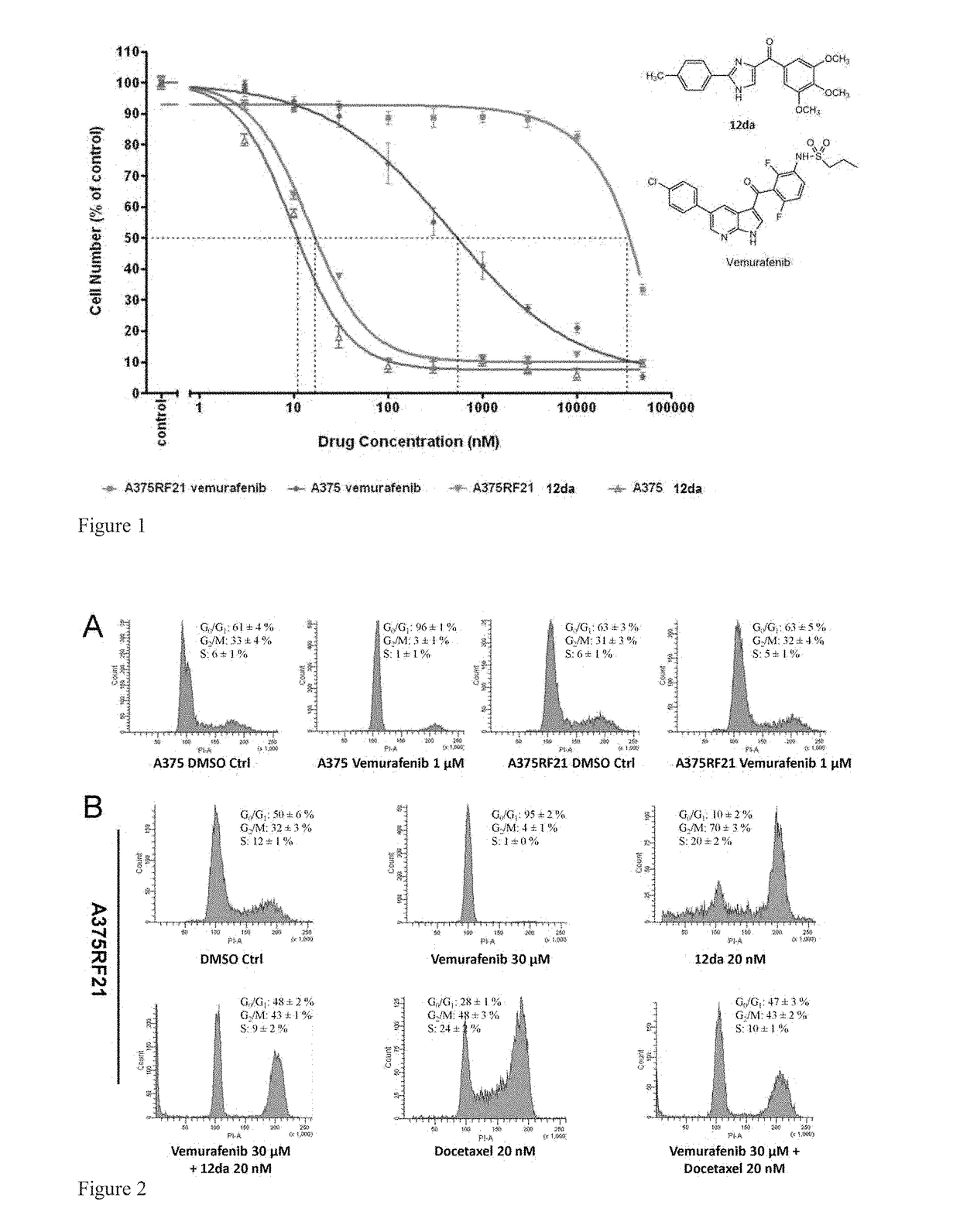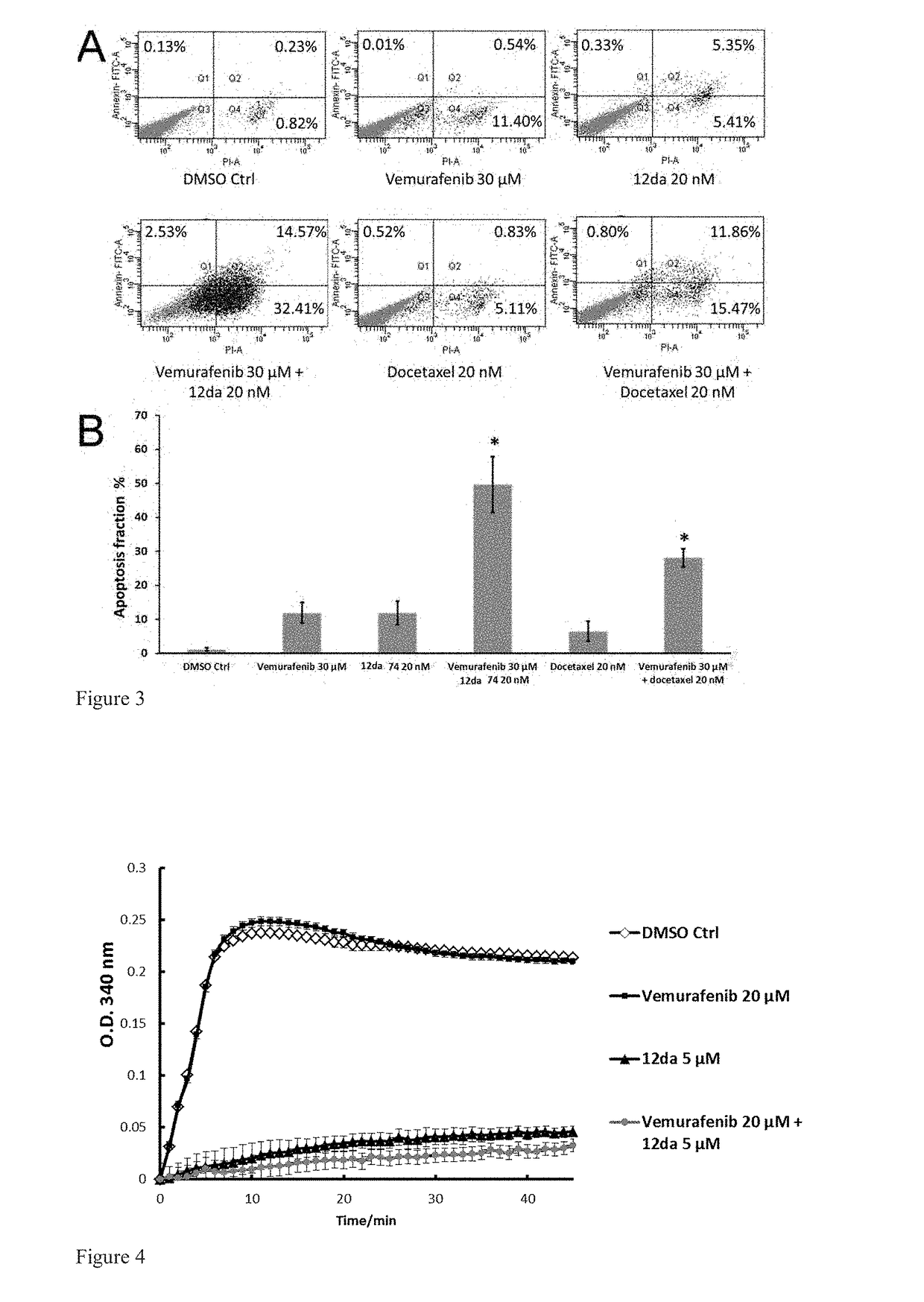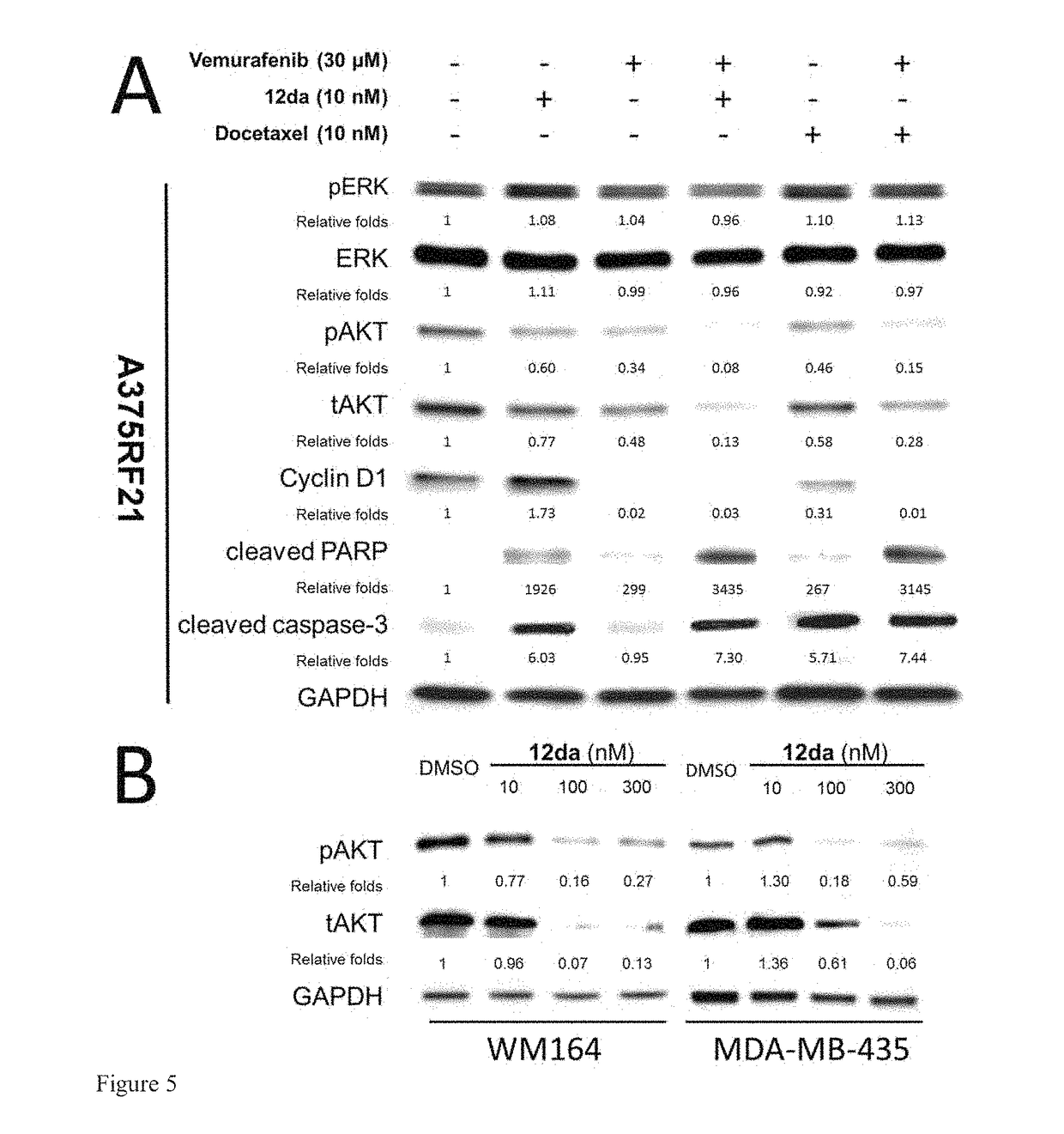Compounds for treatment of cancer
a cancer and compound technology, applied in the field of compound for cancer treatment, can solve the problems of poor prognosis of advanced/metastatic melanoma, year survival rate, and ineffective treatment of advanced/metastatic melanoma, so as to reduce the risk, reduce the severity, and reduce the effect of severity
- Summary
- Abstract
- Description
- Claims
- Application Information
AI Technical Summary
Benefits of technology
Problems solved by technology
Method used
Image
Examples
example 1
Combination of Compound 12da or 17ya and Vemurafenib for Treatment of BRAF Mutant Melanoma and Vemurafenib Resistant Cancer
[0234]Vemurafenib is a novel anti-melanoma drug which is approved for V600E mutants but develops resistance over the course of ˜9 months. Several tubulin inhibitors including compounds 12da and 17ya were screened to evaluate their anti-proliferation combination effects with vemurafenib on parental A375 and MDA-MB-435 cells which were both BRAF V600E mutant cell lines. These combinations may help overcome resistance.
[0235]A hypothesis of synergistic cell cycle arrest by the combinations of vemurafenib with 12da or docetaxel was tested in a panel of BRAFV600E mutant parental melanoma cell lines and chronically selected vemurafenib-resistant A375RF21 subline (Su F, Bradley W D, Wang Q, et al. “Resistance to selective BRAF inhibition can be mediated by modest upstream pathway activation.”Cancer Res. (2012) 72: 969-978). The established vemurafenib-resistant A375RF21...
example 2
Synthesis of Selected Aryl-Benzoyl-Imidazole Compounds
[0272]
Preparation of 2-aryl-4,5-dihydro-1H-imidazoles 14b, 14c, 14x (FIG. 8)
[0273]
[0274]To a solution of appropriate benzaldehyde 8(b, c, x) (60 mmol) in t-BuOH (300 mL) was added ethylenediamine (66 mmol) and stirred for 30 min at RT. Potassium carbonate (75 mmol) and iodine (180 mmol) were added to the reaction mixture sequentially followed by stirring at 70° C. for 3 h. Sodium sulfite (Na2SO3) was added and the mixture was extracted by chloroform. The organic layer was dried over magnesium sulfate and concentrated. The residue was purified by flash column chromatography (chloroform: methanol 20:1) to give a white solid. Yield: 50-60%.
Preparation of 2-aryl-1H-imidazoles (9a-j, p, x; FIGS. 8 and 9)
[0275]
[0276]Method A (essential for only 9b, 9x, FIG. 8): To a solution of 2-aryl-4,5-dihydro-1H-imidazole 14b, x (35 mmol) in DMSO (100 mL) was added potassium carbonate (38.5 mmol) and diacetoxyiodobenzene (38.5 mmol). The reaction m...
example 3
Synthesis of (indolyl)-1H-imidazol-4-yl)(3,4,5-trimethoxyphenyl)methanones (17ya), (17yab) and (17yac) (FIG. 14)
Synthesis of (2-(1H-indol-3-yl)-1H-imidazol-4-yl)(3,4,5-trimethoxyphenyl)methanone (17ya)
[0323]
Synthesis of 1-(phenylsulfonyl)-1H-indole-3-carboxaldehyde (8ya)
[0324]To a solution of indole 3-carboxaldehyde (8y) (100 mmol) in ethanol (500 mL) at RT was added potassium hydroxide (1.1 equiv). The mixture was stirred until total solubilization. The ethanol was completely removed in vacuum and the residual was dissolved in acetone (250 mL) followed by adding benzenesulfonyl chloride (1.1 equiv, 110 mmol). The reaction mixture was stirred for half hour. The precipitate was filtered off and the filtrate was concentrated and recrystallized from methanol to give a white solid. Yield: 33%. 1H NMR (500 MHz, CDCl3) δ 10.17 (s, 1H), 8.25-8.39 (m, 2H), 7.97-8.09 (m, 3H), 7.69 (t, J=7.33 Hz, 1H), 7.59 (t, J=7.5 Hz, 2H), 7.39-7.54 (m, 2H). MS (ESI) calcd for C15H11NO3S 285.1. found 286.0 ...
PUM
| Property | Measurement | Unit |
|---|---|---|
| diameter | aaaaa | aaaaa |
| concentrations | aaaaa | aaaaa |
| temperature | aaaaa | aaaaa |
Abstract
Description
Claims
Application Information
 Login to View More
Login to View More - R&D
- Intellectual Property
- Life Sciences
- Materials
- Tech Scout
- Unparalleled Data Quality
- Higher Quality Content
- 60% Fewer Hallucinations
Browse by: Latest US Patents, China's latest patents, Technical Efficacy Thesaurus, Application Domain, Technology Topic, Popular Technical Reports.
© 2025 PatSnap. All rights reserved.Legal|Privacy policy|Modern Slavery Act Transparency Statement|Sitemap|About US| Contact US: help@patsnap.com



